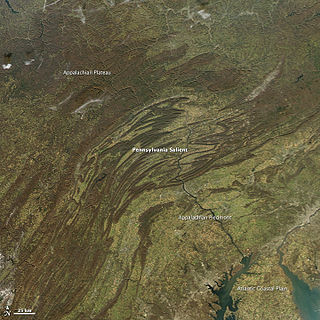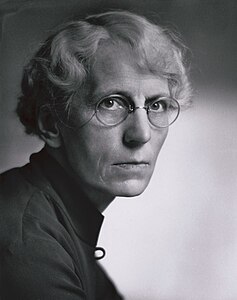
Portland cement is the most common type of cement in general use around the world as a basic ingredient of concrete, mortar, stucco, and non-specialty grout. It was developed from other types of hydraulic lime in England in the early 19th century by Joseph Aspdin, and is usually made from limestone. It is a fine powder, produced by heating limestone and clay minerals in a kiln to form clinker, grinding the clinker, and adding 2 to 3 percent of gypsum. Several types of portland cement are available. The most common, called ordinary portland cement (OPC), is grey, but white portland cement is also available. Its name is derived from its resemblance to Portland stone which was quarried on the Isle of Portland in Dorset, England. It was named by Joseph Aspdin who obtained a patent for it in 1824. However, his son William Aspdin is regarded as the inventor of "modern" portland cement due to his developments in the 1840s.

Calcite is a carbonate mineral and the most stable polymorph of calcium carbonate (CaCO3). The Mohs scale of mineral hardness, based on scratch hardness comparison, defines value 3 as "calcite".

Reinforced concrete (RC), also called reinforced cement concrete (RCC), is a composite material in which concrete's relatively low tensile strength and ductility are compensated for by the inclusion of reinforcement having higher tensile strength or ductility. The reinforcement is usually, though not necessarily, steel bars (rebar) and is usually embedded passively in the concrete before the concrete sets. Worldwide, in volume terms it is an absolutely key engineering material.

The geology of the Appalachians dates back to more than 480 million years ago. A look at rocks exposed in today's Appalachian Mountains reveals elongate belts of folded and thrust faulted marine sedimentary rocks, volcanic rocks and slivers of ancient ocean floor – strong evidence that these rocks were deformed during plate collision. The birth of the Appalachian ranges marks the first of several mountain building plate collisions that culminated in the construction of the supercontinent Pangaea with the Appalachians and neighboring Little Atlas near the center. These mountain ranges likely once reached elevations similar to those of the Alps and the Rocky Mountains before they were eroded.

A concretion is a hard, compact mass of matter formed by the precipitation of mineral cement within the spaces between particles, and is found in sedimentary rock or soil. Concretions are often ovoid or spherical in shape, although irregular shapes also occur. The word 'concretion' is derived from the Latin concretio "(act of) compacting, condensing, congealing, uniting", itself from con meaning 'together' and crescere meaning "to grow". Concretions form within layers of sedimentary strata that have already been deposited. They usually form early in the burial history of the sediment, before the rest of the sediment is hardened into rock. This concretionary cement often makes the concretion harder and more resistant to weathering than the host stratum.
Ian D. Clark is a professor in the Department of Earth Sciences at the University of Ottawa (Canada), who has been publishing research on geoscience, groundwater and geochemistry since 1982, and is currently teaching GEO 1111 with David Schneider. His graduate work in isotope hydrogeology was at the University of Waterloo and the University of Paris.

Alice Evelyn Wilson, MBE, FRSC, FRCGS was Canada's first female geologist. Her scientific studies of rocks and fossils in the Ottawa region between 1913 and 1963 remain a respected source of knowledge.

Lime is a calcium-containing inorganic mineral composed primarily of oxides, and hydroxide, usually calcium oxide and/ or calcium hydroxide. It is also the name for calcium oxide which occurs as a product of coal-seam fires and in altered limestone xenoliths in volcanic ejecta. The word lime originates with its earliest use as building mortar and has the sense of sticking or adhering.
Alenka Zupančič is a Slovenian philosopher whose work focuses on psychoanalysis and continental philosophy. She is a Slovenian psychoanalytic theorist and philosopher who along with Mladen Dolar and Slavoj Žižek have in large measure been responsible for the popularity in North America of a politically infused Lacanian psychoanalysis.
Ground-granulated blast-furnace slag is obtained by quenching molten iron slag from a blast furnace in water or steam, to produce a glassy, granular product that is then dried and ground into a fine powder. Ground-granulated blast furnace slag is highly cementitious and high in calcium silicate hydrates (CSH) which is a strength enhancing compound which improves the strength, durability and appearance of the concrete.

Construction aggregate, or simply aggregate, is a broad category of coarse- to medium-grained particulate material used in construction, including sand, gravel, crushed stone, slag, recycled concrete and geosynthetic aggregates. Aggregates are the most mined materials in the world. Aggregates are a component of composite materials such as concrete and asphalt; the aggregate serves as reinforcement to add strength to the overall composite material. Due to the relatively high hydraulic conductivity value as compared to most soils, aggregates are widely used in drainage applications such as foundation and French drains, septic drain fields, retaining wall drains, and roadside edge drains. Aggregates are also used as base material under foundations, roads, and railroads. In other words, aggregates are used as a stable foundation or road/rail base with predictable, uniform properties, or as a low-cost extender that binds with more expensive cement or asphalt to form concrete.

Radiolarite is a siliceous, comparatively hard, fine-grained, chert-like, and homogeneous sedimentary rock that is composed predominantly of the microscopic remains of radiolarians. This term is also used for indurated radiolarian oozes and sometimes as a synonym of radiolarian earth. However, radiolarian earth is typically regarded by Earth scientists to be the unconsolidated equivalent of a radiolarite. A radiolarian chert is well-bedded, microcrystalline radiolarite that has a well-developed siliceous cement or groundmass.

The alkali–silica reaction (ASR), more commonly known as "concrete cancer", is a deleterious swelling reaction that occurs over time in concrete between the highly alkaline cement paste and the reactive amorphous silica found in many common aggregates, given sufficient moisture.

The Bend Arch–Fort Worth Basin Province is a major petroleum producing geological system which is primarily located in North Central Texas and southwestern Oklahoma. It is officially designated by the United States Geological Survey (USGS) as Province 045 and classified as the Barnett-Paleozoic Total Petroleum System (TPS).

Concrete degradation may have various causes. Concrete can be damaged by fire, aggregate expansion, sea water effects, bacterial corrosion, calcium leaching, physical damage and chemical damage. This process adversely affects concrete exposed to these damaging stimuli.

The Potsdam Sandstone, more formally known as the Potsdam Group, is a geologic unit of mid-to-late Cambrian age found in Northern New York and northern Vermont and Quebec and Ontario. A well-cemented sandstone of nearly pure quartz, in the 19th century it was widely used in construction and in refractory linings for iron furnaces.
Helen Margaret Duncan was a geologist and paleontologist with the United States Geological Survey from 1945 to 1971, where she worked in the Paleontology and Stratigraphy Branch. Duncan was considered one of the strongest women in the Cincinnati geology department; her contributions to the Lipalian Research Foundation and the Pick and Hammer shows were additional work of her time. Duncan paved the path for many geology scholars to follow with her discoveries on fossil records and her studies in paleontology and stratigraphy.
Madeleine Alberta Fritz was a Canadian palaeontologist. She was a professor at the University of Toronto, where she taught vertebrate studies in the department of Geology. Fritz's writing on the fossil Bryozoa along with her research on the stratigraphy of Toronto and the surrounding areas were major contributions to the geological field.

Adela Žgur was a Slovene academic, who prepared the first English textbooks for secondary students in Slovenia. Holding degrees in German and English language and literature, much of her published work was translation-based. During World War II, because of her work with the Liberation Front, she was imprisoned. At the end of the war, she served as a translator at the Paris Peace Conference of 1946. In 1951, she was awarded a Carnegie Fellowship and spent a year observing educational practices in the United States.














